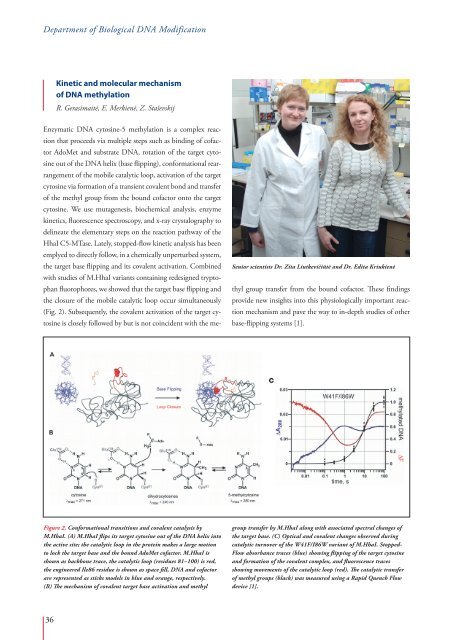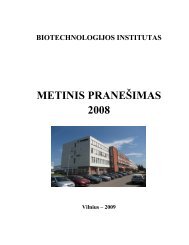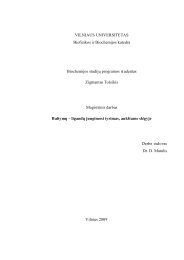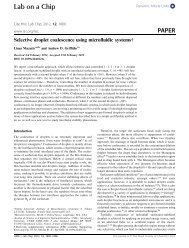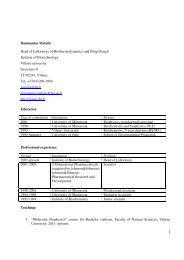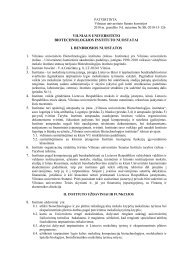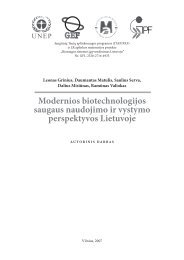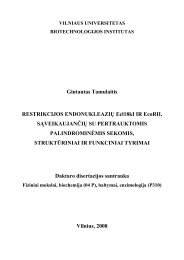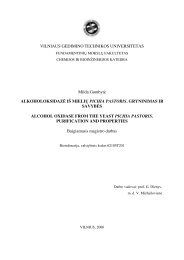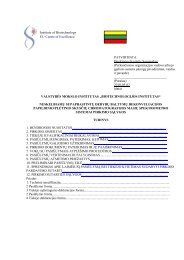Biennial Report 2011â2012
Biennial Report 2011â2012
Biennial Report 2011â2012
You also want an ePaper? Increase the reach of your titles
YUMPU automatically turns print PDFs into web optimized ePapers that Google loves.
Department of Biological DNA Modification<br />
Kinetic and molecular mechanism<br />
of DNA methylation<br />
R. Gerasimaitė, E. Merkienė, Z. Staševskij<br />
Enzymatic DNA cytosine-5 methylation is a complex reaction<br />
that proceeds via multiple steps such as binding of cofactor<br />
AdoMet and substrate DNA, rotation of the target cytosine<br />
out of the DNA helix (base flipping), conformational rearrangement<br />
of the mobile catalytic loop, activation of the target<br />
cytosine via formation of a transient covalent bond and transfer<br />
of the methyl group from the bound cofactor onto the target<br />
cytosine. We use mutagenesis, biochemical analysis, enzyme<br />
kinetics, fluorescence spectroscopy, and x-ray crystalography to<br />
delineate the elementary steps on the reaction pathway of the<br />
HhaI C5-MTase. Lately, stopped-flow kinetic analysis has been<br />
emplyed to directly follow, in a chemically unperturbed system,<br />
the target base flipping and its covalent activation. Combined<br />
with studies of M.HhaI variants containing redesigned tryptophan<br />
fluorophores, we showed that the target base flipping and<br />
the closure of the mobile catalytic loop occur simultaneously<br />
(Fig. 2). Subsequently, the covalent activation of the target cytosine<br />
is closely followed by but is not coincident with the me-<br />
Senior scientists Dr. Zita Liutkevičiūtė and Dr. Edita Kriukienė<br />
thyl group transfer from the bound cofactor. These findings<br />
provide new insights into this physiologically important reaction<br />
mechanism and pave the way to in-depth studies of other<br />
base-flipping systems [1].<br />
Figure 2. Conformational transitions and covalent catalysis by<br />
M.HhaI. (A) M.HhaI flips its target cytosine out of the DNA helix into<br />
the active site; the catalytic loop in the protein makes a large motion<br />
to lock the target base and the bound AdoMet cofactor. M.HhaI is<br />
shown as backbone trace, the catalytic loop (residues 81–100) is red,<br />
the engineered Ile86 residue is shown as space fill, DNA and cofactor<br />
are represented as sticks models in blue and orange, respectively.<br />
(B) The mechanism of covalent target base activation and methyl<br />
group transfer by M.HhaI along with associated spectral changes of<br />
the target base. (C) Optical and covalent changes observed during<br />
catalytic turnover of the W41F/I86W variant of M.HhaI. Stopped-<br />
Flow absorbance traces (blue) showing flipping of the target cytosine<br />
and formation of the covalent complex, and fluorescence traces<br />
showing movements of the catalytic loop (red). The catalytic transfer<br />
of methyl groups (black) was measured using a Rapid Quench Flow<br />
device [1].<br />
36


